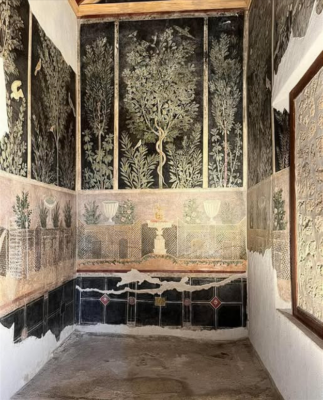Introduction to the House of the Orchard
Pompeii, the ancient Roman city buried by the eruption of Mount Vesuvius in 79 AD, continues to reveal astonishing historical and artistic treasures. Among its many preserved structures, the House of the Orchard stands out due to its breathtaking frescoes depicting lush gardens and fruit-bearing trees. Despite being smaller than some neighboring villas, this house captivates visitors with its artistic mastery and insight into Roman domestic life.
Location and Discovery
The House of the Orchard is situated in Regio I, Insula 9, a residential area of Pompeii known for its well-preserved homes and artistic significance. Archaeologists unearthed this structure in the early 1900s, uncovering a home that had undergone multiple renovations before being ultimately buried by volcanic ash.
Historical Background
Believed to have been built in the 3rd century BC, the House of the Orchard saw significant modifications over time. The intricate frescoes and architectural elements suggest that it belonged to a family of considerable wealth, showcasing their appreciation for beauty and nature.

The Artistic Marvels of the House of the Orchard
The House of the Orchard is renowned for its stunning frescoes, which depict a serene and flourishing garden setting. These paintings offer a rare glimpse into the artistic techniques and themes favored by the ancient Romans.
The Famous Garden Frescoes
The walls of the house are adorned with elaborate frescoes of fruit-bearing trees, flowering plants, and lush greenery. The detailed depiction of nature not only served as decoration but also created an illusion of an open, airy space, enhancing the overall ambiance of the home.
Symbolism and Artistic Influence
The frescoes are believed to symbolize fertility, prosperity, and a connection to nature, all central themes in Roman culture. These artworks reflect influences from Greek and Hellenistic styles, demonstrating the cosmopolitan nature of Pompeian society.
The Architectural Features of the House
Although not the largest residence in Pompeii, the House of the Orchard boasts a unique architectural layout designed for comfort and aesthetic appeal.
Structure and Layout
The house consists of a central atrium surrounded by smaller rooms, a common feature in Roman homes. The open courtyard likely served as a gathering place, allowing sunlight to illuminate the interior spaces.
Renovations and Modifications
Over time, the house underwent several modifications, including enhancements to the frescoes and structural improvements. These changes suggest that the residents valued both functionality and artistic refinement.
The Impact of Mount Vesuvius’ Eruption
Like the rest of Pompeii, the House of the Orchard was buried under layers of volcanic ash, preserving its artwork and architecture for centuries.
Preservation of the Frescoes
The eruption of Mount Vesuvius inadvertently protected the frescoes by sealing them beneath the ash, preventing natural erosion and human interference until their rediscovery.
Archaeological Significance
The discovery of the house provided valuable insights into Roman interior design, artistic expression, and daily life, making it one of Pompeii’s most significant findings.
Modern Restoration and Reopening
Following extensive preservation efforts, the House of the Orchard has recently reopened to the public, allowing visitors to admire its historical beauty.
Restoration Efforts
Experts meticulously cleaned and restored the frescoes, ensuring their longevity while maintaining their original splendor. Structural reinforcements were also made to preserve the integrity of the house.
A Must-See Destination
Today, the House of the Orchard is a popular attraction for history and art enthusiasts, offering an immersive experience into the world of ancient Rome. Its reopening marks a new chapter in Pompeii’s ongoing journey of discovery.
Conclusion: A Testament to Roman Ingenuity
The House of the Orchard is more than just an ancient residence; it is a masterpiece of Roman art and architecture. Its detailed frescoes, thoughtful design, and historical significance make it a must-visit site for anyone exploring Pompeii. As restoration efforts continue, this remarkable home will remain a timeless window into the artistic and cultural achievements of the Roman world.

CÁC TIN KHÁC
Mary Walton: The Forgotten Inventor Who Helped Clean Up America’s Cities
Tomb of Queen Nefertari in the Valley of the Queens, Egypt
Discover the Hypostyle Hall of the Temple of Hathor at Dendera
Venus de Losange: Unveiling the Mystery of a 20,000-Year-Old Paleolithic Icon